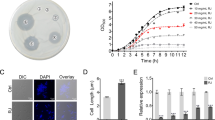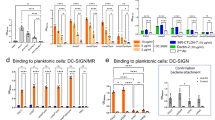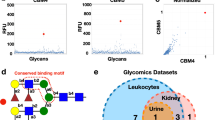Abstract
Pseudomonas aeruginosa antibiotic resistance has led to the search of natural compounds, which would competitively block its fucose>fructose/mannose-binding lectin (PA-IIL) that mediates its biofilm formation and adhesion to animal cells. Such compounds were found in human milk (HM) and avian egg whites. The present research has revealed that honey and royal jelly (RJ), which are assigned to protect beehive progeny and are applied for human infection therapy, match HM in PA-IIL blocking. The function of their fructose (higher in honey) and mannosylated glycoproteins (higher in RJ) as powerful decoys in PA-IIL neutralization is of ecological/biological importance and implementability for the antibacterial adhesion therapeutic strategy.
Similar content being viewed by others
Log in or create a free account to read this content
Gain free access to this article, as well as selected content from this journal and more on nature.com
or
References
Albert S, Bhattacharya D, Klaudiny J, Schmitzova J, Simuth J . (1999). The family of major royal jelly proteins and its evolution. J Mol Evol 49: 290–297.
Albert S, Klaudiny J . (2004). The MRJP/YELLOW protein family of Apis mellifera: identification of new members in the EST library. J Insect Physiol 50: 51–59.
Cooper RA, Halas E, Molan PC . (2002). The efficacy of honey in inhibiting strains of Pseudomonas aeruginosa from infected burns. J Burn Care Rehabil 23: 366–370.
Diggle SP, Stacey RE, Dodd C, Camara M, Williams P, Winzer K . (2006). The galactophilic lectin, LecA, contributes to biofilm development in Pseudomonas aeruginosa. Environ Microbiol 8: 1095–1104.
Drapeau MD, Albert S, Kucharski R, Prusko C, Maleszka R . (2006). Evolution of the Yellow/Major Royal Jelly Protein family and the emergence of social behavior in honey bees. Genome Res 16: 1385–1394.
French VM, Cooper RA, Molan PC . (2005). The antibacterial activity of honey against coagulase-negative staphylococci. J Antimicrob Chemother 56: 228–231.
Gilboa-Garber N . (1982). Pseudomonas aeruginosa lectins. Methods Enzymol 83: 378–385.
Gilboa-Garber N . (1996). Towards anti-Pseudomonas aeruginosa adhesion therapy. Adv Exp Med Biol 408: 39–50.
Gilboa-Garber N, Avichezer D, Garber NC . (1997). Bacterial lectins: properties, structure, effects, function and applications. In: Gabius H-J, Gabius S (eds). Glycosciences: Status and Perspectives. Chapman & Hall: Weinheim, pp 369–398.
Kimura M, Hama Y, Tsumura K, Okihara K, Sugimoto H, Yamada H et al. (2002). Occurrence of GalNAcbeta1-4GlcNAc unit in N-glycan of royal jelly glycoprotein. Biosci Biotechnol Biochem 66: 1985–1989.
Kimura Y, Miyagi C, Kimura M, Nitoda T, Kawai N, Sugimoto H . (2000). Structural features of N-glycans linked to royal jelly glycoproteins: structures of high-mannose type, hybrid type, and biantennary type glycans. Biosci Biotechnol Biochem 64: 2109–2120.
Konami Y, Yamamoto K, Osawa T . (1991). The primary structures of two types of the Ulex europeus seed lectin. J Biochem (Tokyo) 109: 650–658.
Laemmli UK . (1970). Cleavage of structural proteins during the assembly of the head of bacteriophage T4. Nature 227: 680–685.
Lerrer B, Gilboa-Garber N . (2001). Interactions of Pseudomonas aeruginosa PA-II lectin with quail egg white glycoproteins. Can J Microbiol 47: 1095–1100.
Lesman-Movshovich E, Gilboa-Garber N . (2003). Pseudomonas aeruginosa lectin PA-IIL as a powerful probe for human and bovine milk analysis. J Dairy Sci 86: 2276–2282.
Lesman-Movshovich E, Lerrer B, Gilboa-Garber N . (2003). Blocking of Pseudomonas aeruginosa lectins by human milk glycans. Can J Microbiol 49: 230–235.
Majtan J, Kovacova E, Bilikova K, Simuth J . (2006). The immunostimulatory effect of the recombinant apalbumin 1-major honeybee royal jelly protein-on TNFalpha release. Int Immunopharmacol 6: 269–278.
Mitchell E, Houles C, Sudakevitz D, Wimmerova M, Gautier C, Perez S et al. (2002). Structural basis for oligosaccharide-mediated adhesion of Pseudomonas aeruginosa in the lung of cystic fibrosis patients. Nat Struct Biol 9: 918–921.
Molan PC . (2006). The evidence supporting the use of honey as a wound dressing. Int J Low Extrem Wounds 5: 40–54.
Moothoo DN, Naismith JH . (1998). Concanavalin A distorts the beta-GlcNAc-(1 → 2)-Man linkage of beta-GlcNAc-(1 → 2)-alpha-Man-(1 → 3)-[beta-GlcNAc-(1 → 2)-alpha-Man-(1 → 6)]-Man upon binding. Glycobiology 8: 173–181.
Moritz RFA, Southwick EE . (1992). Bees as Superorganisms – An Evolutionary Reality. Springer Verlag: Berlin, Heidelberg.
Morrow AL, Ruiz-Palacios GM, Jiang X, Newburg DS . (2005). Human-milk glycans that inhibit pathogen binding protect breast-feeding infants against infectious diarrhea. J Nutr 135: 1304–1307.
Newburg DS, Ruiz-Palacios GM, Morrow AL . (2005). Human milk glycans protect infants against enteric pathogens. Annu Rev Nutr 25: 37–58.
Nicas TI, Iglewski BH . (1985). The contribution of exoproducts to virulence of Pseudomonas aeruginosa. Can J Microbiol 31: 387–392.
Perret S, Sabin C, Dumon C, Pokorna M, Gautier C, Galanina O et al. (2005). Structural basis for the interaction between human milk oligosaccharides and the bacterial lectin PA-IIL of Pseudomonas aeruginosa. Biochem J 389: 325–332.
Qiu PY, Ding HB, Tang YK, Xu RJ . (1999). Determination of chemical composition of commercial honey by near-infrared spectroscopy. J Agric Food Chem 47: 2760–2765.
Ruiz-Palacios GM, Cervantes LE, Ramos P, Chavez-Munguia B, Newburg DS . (2003). Campylobacter jejuni binds intestinal H(O) antigen (Fuc alpha 1, 2Gal beta 1, 4GlcNAc), and fucosyloligosaccharides of human milk inhibit its binding and infection. J Biol Chem 278: 14112–14120.
Sano O, Kunikata T, Kohno K, Iwaki K, Ikeda M, Kurimoto M . (2004). Characterization of royal jelly proteins in both Africanized and European honeybees (Apis mellifera) by two-dimensional gel electrophoresis. J Agric Food Chem 52: 15–20.
Santos KS, dos Santos LD, Mendes MA, de Souza BM, Malaspina O, Palma MS . (2005). Profiling the proteome complement of the secretion from hypopharyngeal gland of Africanized nurse-honeybees (Apis mellifera L.). Insect Biochem Mol Biol 35: 85–91.
Scarselli R, Donadio E, Giuffrida MG, Fortunato D, Conti A, Balestreri E et al. (2005). Towards royal jelly proteome. Proteomics 5: 769–776.
Schmitzova J, Klaudiny J, Albert S, Schroder W, Schreckengost W, Hanes J et al. (1998). A family of major royal jelly proteins of the honeybee Apis mellifera L. Cell Mol Life Sci 54: 1020–1030.
Sharon N . (2006). Carbohydrates as future anti-adhesion drugs for infectious diseases. Biochim Biophys Acta 1760: 527–537.
Simuth J, Bilikova K, Kovacova E, Kuzmova Z, Schroder W . (2004). Immunochemical approach to detection of adulteration in honey: physiologically active royal jelly protein stimulating TNF-alpha release is a regular component of honey. J Agric Food Chem 52: 2154–2158.
Stocker A, Schramel P, Kettrup A, Bengsch E . (2005). Trace and mineral elements in royal jelly and homeostatic effects. J Trace Elem Med Biol 19: 183–189.
Takenaka T . (1982). Chemical composition of royal jelly. Honeybee Sci 3: 69–74.
Taormina PJ, Niemira BA, Beuchat LR . (2001). Inhibitory activity of honey against foodborne pathogens as influenced by the presence of hydrogen peroxide and level of antioxidant power. Int J Food Microbiol 69: 217–225.
Tielker D, Hacker S, Loris R, Strathmann M, Wingender J, Wilhelm S et al. (2005). Pseudomonas aeruginosa lectin LecB is located in the outer membrane and is involved in biofilm formation. Microbiology 151: 1313–1323.
Tonks AJ, Cooper RA, Jones KP, Blair S, Parton J, Tonks A . (2003). Honey stimulates inflammatory cytokine production from monocytes. Cytokine 21: 242–247.
Acknowledgements
The authors express their gratitude to Ms Sharon Victor and Ms Ela Gindy for their help in the preparation of this manuscript and its graphic presentation. This work is part of the PhD thesis of KZ-Y in Bar-Ilan University.
Author information
Authors and Affiliations
Corresponding author
Rights and permissions
About this article
Cite this article
Lerrer, B., Zinger-Yosovich, K., Avrahami, B. et al. Honey and royal jelly, like human milk, abrogate lectin-dependent infection-preceding Pseudomonas aeruginosa adhesion. ISME J 1, 149–155 (2007). https://doi.org/10.1038/ismej.2007.20
Received:
Revised:
Accepted:
Published:
Issue date:
DOI: https://doi.org/10.1038/ismej.2007.20
Keywords
This article is cited by
-
Sericulture and the edible-insect industry can help humanity survive: insects are more than just bugs, food, or feed
Food Science and Biotechnology (2022)
-
Organ-specific transcriptome analysis reveals differential gene expression in different castes under natural conditions in Apis cerana
Scientific Reports (2021)
-
Honey can inhibit and eliminate biofilms produced by Pseudomonas aeruginosa
Scientific Reports (2019)
-
Antibacterial activity of Thymoquinone, an active principle of Nigella sativa and its potency to prevent bacterial biofilm formation
BMC Complementary and Alternative Medicine (2011)



